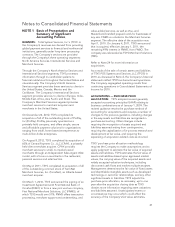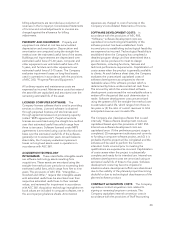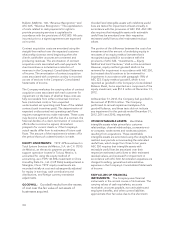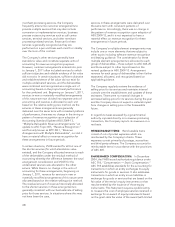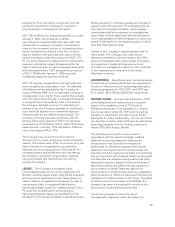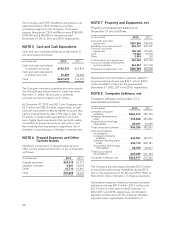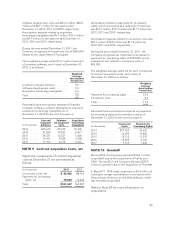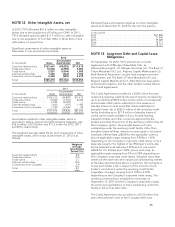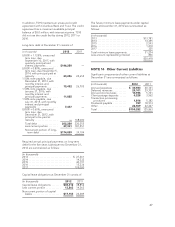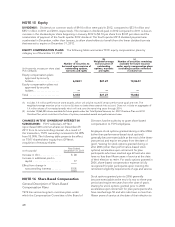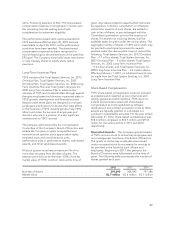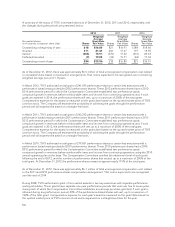NetSpend 2012 Annual Report Download - page 43
Download and view the complete annual report
Please find page 43 of the 2012 NetSpend annual report below. You can navigate through the pages in the report by either clicking on the pages listed below, or by using the keyword search tool below to find specific information within the annual report.
challenge by various taxing authorities. Contingency
reserves are periodically established where the
amount of the contingency can be reasonably
determined and is likely to occur. Reductions in
contingency reserves are recognized when tax
disputes are settled or examination periods lapse.
Significant estimates used in accounting for income
taxes relate to the determination of taxable income,
the determination of temporary differences between
book and tax basis, as well as estimates on the
realizability of tax credits and net operating losses.
TSYS recognizes potential interest and penalties
related to the underpayment of income taxes as
income tax expense in the Consolidated Statements
of Income.
EARNINGS PER SHARE: In June 2008, the FASB
issued authoritative guidance under ASC 260,
“Earnings Per Share.” The guidance under ASC 260
holds that unvested share-based payment awards
that contain nonforfeitable rights to dividends or
dividend equivalents are “participating securities” as
defined in ASC 260, and therefore should be
included in EPS using the two-class method.
The two-class method is an earnings allocation
method for computing EPS when an entity’s capital
structure includes two or more classes of common
stock or common stock and participating securities. It
determines EPS based on dividends declared on
common stock and participating securities and
participation rights of participating securities in any
undistributed earnings.
Basic EPS is calculated by dividing net income by the
weighted average number of common shares
outstanding during the period. Diluted EPS is
calculated to reflect the potential dilution that would
occur if stock options or other contracts to issue
common stock were exercised. Diluted EPS is
calculated by dividing net income by weighted
average common and common equivalent shares
outstanding. Common equivalent shares are
calculated using the treasury stock method.
RECLASSIFICATIONS: Certain reclassifications
have been made to the 2011 and 2010 financial
statements to conform to the presentation adopted
in 2012.
NOTE 2 Discontinued Operations
The Company sold certain assets and liabilities of
TPOS on September 30, 2010. The sale of certain
assets and liabilities of TPOS was the result of
management’s decision during the third quarter of
2010 to divest non-strategic businesses and focus
resources on core products and services. The
Company had a pre-tax goodwill impairment of
$2.2 million (approximately $1.5 million after-tax)
related to TPOS, which was included in discontinued
operations as part of the sale. This transaction
resulted in the assumed lease of its Sacramento,
California, facility and the closure of its Columbus,
Georgia-based distribution center.
TSYS will continue to use the buyer in a referral
arrangement for customers who approach the
Company for terminal services but will not have
significant continuing involvement after the sale to
the buyer.
TPOS was neither a significant component of the
Merchant Services segment, nor TSYS’ consolidated
results.
In accordance with the provisions of ASC 205, the
Company determined the TPOS business became a
discontinued operation in the third quarter of 2010.
The following table presents the summarized results
of discontinued operations for the year ended
December 31, 2010:
(in thousands) 2010
Total revenues ........................ $ 7,430
Operating loss ........................ $(1,840)
Income taxes ......................... $ (621)
Loss from discontinued operations, net of
tax ................................ $(1,243)
Loss on disposition, net of tax ........... $(2,002)
The Consolidated Statements of Cash Flows include
TPOS through the respective date of disposition.
NOTE 3 Fair Value Measurement
ASC 820, “Fair Value Measurements and Disclosure,”
requires disclosure about how fair value is
determined for assets and liabilities and establishes a
hierarchy for which these assets and liabilities must
be grouped, based on significant level of inputs. The
three-tier fair value hierarchy, which prioritizes the
inputs used in the valuation methodologies, is as
follows:
Level 1 — Quoted prices for identical assets and
liabilities in active markets.
40



